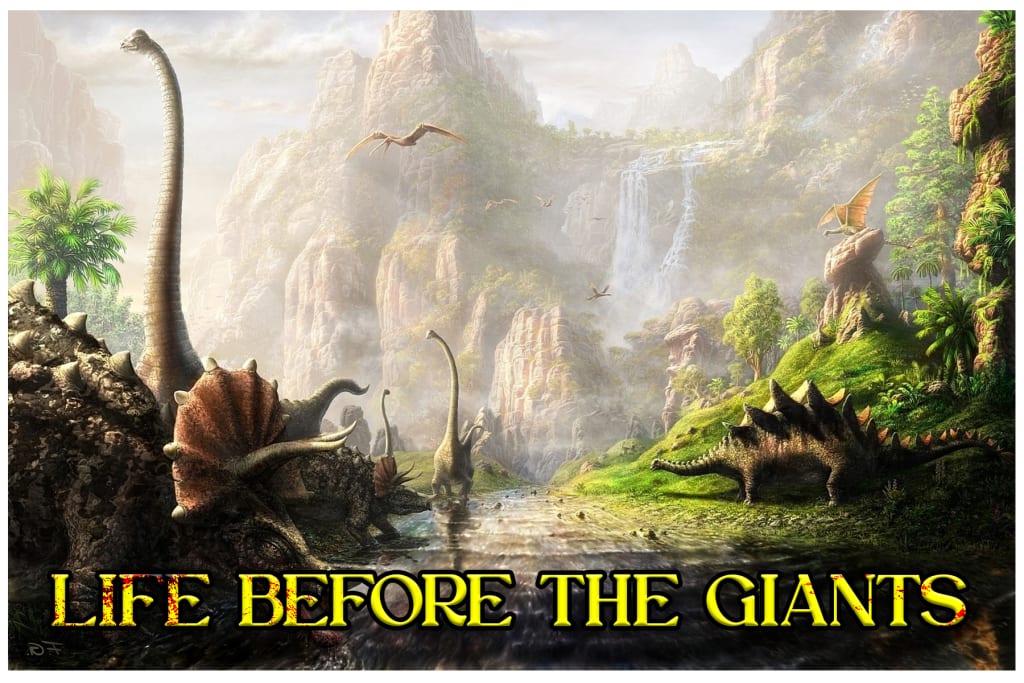"Life Before the Giants: Unveiling Earth's Pre-Dinosaur Era"
Exploring Earth's Ancient Chronicles: Unearthing the Mysteries of Pre-Dinosaur Times.

Before the age of dinosaurs, which captures the imagination with their colossal presence, Earth's history stretches back millions of years. However, life on our planet began long before these giants roamed the Earth. Let's embark on an intriguing voyage, tracing Earth's earliest days to the emergence of dinosaurs.
Let's rewind to around 4.6 billion years ago, when remnants of the Sun's formation coalesced into massive space rocks, eventually forming Earth through countless collisions and mergers. But this early Earth was anything but familiar; it was a seething cauldron of molten lava, radiation, and relentless asteroid bombardment. This fiery stage persisted for eons.
Fast forward nearly a billion years to around 3.7 billion years ago, when Earth had cooled considerably, resembling its present form in temperature. However, it remained a harsh environment, dominated by vast oceans and a nearly oxygen-free atmosphere, with volcanic activity punctuating the eerie silence.
Despite these inhospitable conditions, a remarkable event occurred deep within the primordial seas: the emergence of life. While the exact mechanisms remain a mystery, a fortuitous combination of environmental factors led to the birth of simple, single-celled organisms. Some of these early life forms even began producing oxygen, laying the foundation for the planet's future evolution. For billions of years, these microscopic pioneers thrived, quietly shaping Earth's destiny. What a life.
As time passed, these early life forms gradually underwent transformations, growing more intricate. This evolutionary journey culminated at the dawn of the Cambrian period, approximately 538 million years ago. Prior to this period, Earth was dominated by a single supercontinent known as Rodinia. However, as the Cambrian commenced, Rodinia fragmented into smaller landmasses, with Gondwana emerging as the largest in the southeastern region.
But the real spectacle was yet to unfold: the Cambrian explosion, a phenomenon unparalleled in the annals of Earth's history. This explosion, while not a literal burst of flames, symbolizes the unprecedented emergence of a multitude of new life forms. The era of single-celled organisms was over; now, complexity was in vogue. Many of the fundamental body plans observed in contemporary life forms made their debut during this epoch, with ancestors of crustaceans, mollusks, starfish, and worms diversifying beneath the ocean's surface.
Although the Cambrian explosion unfolded gradually over tens of millions of years, its significance cannot be overstated, especially considering the relatively subdued pace of evolution during the preceding billions of years. Scientists continue to debate the catalysts behind this extraordinary event. Yet, it's worth noting that the oxygen production initiated by some of the original simple organisms likely played a pivotal role in setting the stage for this remarkable burst of life
One theory suggests that these early life forms experienced a rapid proliferation, leading to a substantial increase in oxygen levels. This oxygen boost facilitated the emergence of new, more sophisticated organisms, which in turn preyed upon their simpler counterparts, initiating an evolutionary arms race that would shape life on Earth for eons to come.
Regardless of the precise mechanisms at play, Earth had become a fertile ground for these novel life forms. The planet's average temperature soared, with waters likely reaching around 110 degrees Fahrenheit. Coupled with elevated levels of oxygen and carbon dioxide, this environmental transformation provided the perfect conditions for life to advance. And it certainly did.
During the Cambrian period, a flurry of evolutionary innovations emerged, including eyes, limbs, mouths, exoskeletons, and shells. While many of these early adopters of these upgrades still boasted alien-like appearances, trilobites, for instance, thrived, leaving behind abundant fossils as evidence of their success.
The Cambrian also witnessed the debut of the first fish, initially resembling slimy, jawless eels, marking the advent of true vertebrates. Among the bizarre creatures of this era was Yunnanozoon, with a backbone despite its seemingly spineless form, and the peculiar Opabinia, resembling a child's whimsical creation, equipped with a long beak-like appendage for feeding.
However, reigning supreme amidst this eclectic menagerie was Anomalocaris, the apex predator of its time. This nightmare prawn, measuring over a foot in length—an immense size for its era—stalked the oceans, preying on soft-bodied animals like worms. Yet, just as life seemed to be flourishing and the evolutionary arms race intensified, catastrophe loomed on the horizon around 485 million years ago.
A significant drop in oxygen levels, likely triggered by volcanic activity, resulted in a mass extinction event, although some resilient species like trilobites continued to thrive. Despite this, the event had apocalyptic implications, marking the end of the Cambrian period and the onset of the Ordovician. The Ordovician era was characterized by the Great Ordovician Biodiversification Event (GOBE), spanning approximately 30 million years, during which continents shifted, sea levels fluctuated, and oceanic oxygen levels rebounded. These geological changes created new habitats, fostering a surge in biodiversity as life adapted to the freshly oxygenated waters. Prototype fish evolved into more fish-like forms, while formidable predators like eurypterids, or sea scorpions, emerged, known for their menacing traits. However, even these predators paled in comparison to Cameroceras, a colossal cephalopod that dominated the food chain with its sharp beak capable of cracking through armored exoskeletons. Concurrently, flora began its ascent, as primitive algae evolved and colonized terrestrial habitats, heralding the emergence of mosses on what could be considered quasi-dry land during the Ordovician period.
The migration of early plants to land marked a pivotal moment in Earth's history, despite their lack of specialized structures like roots for water retention. These pioneering plants thrived in damp environments along the edges of waterbodies, laying the groundwork for nature's conquest of terrestrial habitats. Their ability to absorb carbon dioxide from the atmosphere and release oxygen initiated a transformative process, eventually leading to the proliferation of land-dwelling flora and the creation of diverse ecosystems, including the emergence of coral reefs in marine environments.
However, the Ordovician period concluded around 443 million years ago with a devastating mass extinction event triggered by an ice age, during which glaciers covered much of the southern hemisphere, drastically altering global climates and decimating marine animal populations. The success of land-dwelling plants, particularly mosses, in absorbing carbon dioxide from the atmosphere may have contributed to the onset of this ice age, although the precise mechanisms remain debated among scientists.
As the ice age subsided over the following 40 million years, sea levels rose, and the climate stabilized, allowing life to rebound. With the apex predator Cameroceras extinct, sea scorpions ascended to dominance, diversifying and growing even larger, exemplified by the massive Carcinoma reaching over 7 feet in length. Meanwhile, fish continued to evolve, with the first species featuring movable jaws appearing in the Silurian period, alongside the emergence of the first coral reefs.
On land, plant life underwent significant evolution, developing complex, recognizable forms and vascular structures for water absorption and retention. These advancements laid the foundation for modern flora and facilitated the colonization of land by arthropods such as centipedes, millipedes, and scorpions. Although initially venturing onto land for reasons like predator evasion or accessing new food sources, these early terrestrial inhabitants soon embraced the opportunities presented by a new environment, marking a pivotal moment in the colonization of land by animal life.
Life in the ocean was fiercely competitive, but on land, it presented a new realm ripe with possibilities, although not every species that ventured out immediately shed their gills to breathe air. Silurian scorpions, for instance, retained their gills even after transitioning to land and had to keep them moist for survival, likely remaining close to the water's edge. The Silurian period concluded around 419 million years ago with relatively minor extinction events, likely due to changing climates, which, while not catastrophic, still impacted the planet's biodiversity. The subsequent Devonian period emerged as one of the most influential periods in Earth's history since the Cambrian.
During the Devonian, the earliest known sharks appeared, although they were overshadowed by formidable bony fish called placoderms, exemplified by the apex predator Dunkleosteus. This colossal fish, with its massive size and formidable jaws, dominated the oceans, showcasing the remarkable diversity of marine life during this period. Meanwhile, on land, plants underwent significant evolution, giving rise to the first wooded trees, which formed the foundation of the original forests, contributing to increased oxygen levels and absorbing substantial amounts of carbon dioxide, thus creating a more hospitable environment for life to thrive.
As the terrestrial ecosystem flourished, vertebrates began to take notice. Fish like lungfish had already been spending more time in shallow waters, but in the Devonian, they underwent significant evolutionary changes, exemplified by Tiktaalik, an early vertebrate capable of breathing air and navigating both land and water. Similarly, Ichthyostega, one of the first tetrapods, emerged with fully developed limbs, marking a pivotal moment in the transition from aquatic to terrestrial life.
Meanwhile, arthropods diversified on land, with wingless insects and spiders spreading across various habitats. However, for marine creatures, the end of the Devonian period brought harsh declines in oceanic oxygen levels, leading to widespread extinctions as vast swathes of marine life succumbed to oxygen deprivation, altering the course of evolution in the oceans.
The enduring trilobites and sea scorpions suffered devastating losses during the oxygen depletion event, with their populations dwindling to levels from which they would never fully recover. Dominant species like Dunkleosteus were entirely wiped out, contributing to the extinction of up to 70% of all invertebrate species. While the precise cause of the sudden oxygen drop remains uncertain, scientists speculate that it may have been linked to the proliferation of trees during this era, which led to significant alterations in soil composition and nutrient runoff into rivers and oceans. This nutrient influx fueled massive algae blooms, depleting oxygen levels in the water and wreaking havoc on marine ecosystems. Meanwhile, life on land continued to thrive, signaling a shift in the balance of power between terrestrial and aquatic realms.
The subsequent Carboniferous period, beginning 359 million years ago, witnessed a remarkable surge in terrestrial plant life, giving rise to vast jungles and swamplands that blanketed much of the planet. This explosion of foliage led to unprecedented levels of atmospheric oxygen, which had profound effects on the animals of the time. Arthropods, which had invaded land during the Silurian period and had since undergone significant evolutionary adaptations, experienced a surge in size and diversity due to the abundant oxygen and ample food resources provided by the flourishing plant life. Among these giants was the Arthropleura, a car-sized millipede, highlighting the astonishing scale of adaptation and evolution that characterized life during the Carboniferous period.
During the Carboniferous period, the Earth witnessed a surge in terrestrial life, with towering trees and lush jungles covering vast swaths of the planet. This proliferation of plant life led to unprecedented levels of atmospheric oxygen, fueling the evolution of gigantic arthropods like the car-sized Arthropleura and the massive Meganeura, one of the largest flying insects ever recorded. Additionally, tetrapods, including early amphibians like Diplocaulus, flourished both on land and in the water, with remarkable evolutionary adaptations such as the development of hard-shelled eggs that allowed them to reproduce on land without returning to water.
However, the end of the Carboniferous period brought significant changes as Earth's landmasses converged to form the supercontinent Pangea around 335 million years ago. This continental shift fragmented the once-lush rainforests, leading to habitat destruction and a decline in atmospheric oxygen levels. Coupled with dropping temperatures and the onset of glaciation, this transformation spelled the demise of many species, including the giant arthropods. Nonetheless, the amniotes, with their ability to reproduce on land and conserve water, thrived in the changing environment, setting the stage for their dominance in the Permian period.
As the Permian era began, temperatures rose, and glaciers melted, giving way to dry deserts in the inland areas of Pangea. Synapsids and sauropsids, the ancestors of mammals and reptiles/birds respectively, diversified and spread across the supercontinent, becoming the dominant land animals. Among the synapsids, creatures like Dimetrodon emerged as apex predators, evolving traits that would later characterize mammals. Despite its dinosaur-like appearance, Dimetrodon was more closely related to modern mammals and reigned as the top predator of the early Permian, exemplifying the evolutionary transitions that marked this pivotal period in Earth's history.
The Permian period witnessed the rise and fall of remarkable creatures, including the iconic Dimetrodon, adorned with a distinctive sail on its back whose purpose remains debated among scientists. While some argue it helped regulate body temperature, others propose it served as a display for attracting mates. Despite its success, Dimetrodon eventually succumbed after a tenure of 16 million years. Stepping into the role of apex predator in the middle to late Permian were the gorgonopsians, synapsids armed with formidable saber-like canines. Their primary prey included slow-moving sauropsids like Scutosaurus, armored herbivores vulnerable to the gorgonopsians' lethal hunting tactics.
Amidst the Permian era's array of fauna, the Cotylorhynchus emerged as a notable herbivore, although its reign was short-lived. The period took a drastic turn as extensive volcanic eruptions ravaged Siberia over a million years, spewing vast amounts of carbon dioxide into the atmosphere. This influx of CO2 intensified the greenhouse effect, leading to soaring global temperatures and widespread ecological upheaval. Wildfires engulfed remaining forests, releasing further CO2 and exposing rocks that eroded, releasing nutrients into the ocean and triggering an explosion of marine life.
However, this apparent resurgence proved fleeting as the burgeoning marine populations depleted oxygen levels in the seas, leading to widespread suffocation of marine organisms. By the end of the Permian period around 251 million years ago, the planet was in the throes of a catastrophic event dubbed the Great Dying. This mass extinction event, the most severe in Earth's history, decimated approximately 70% of terrestrial species and a staggering 90% of marine life, leaving the planet on the brink of ecological collapse.
Following the catastrophic Great Dying, only a sparse handful of resilient species endured in a world left desolate. The demise of the Permian period marked not just the end of an epoch but the conclusion of the entire Paleozoic era, spanning nearly 300 million years. However, life persisted, transitioning into the Mesozoic era, a time that would eventually witness the rise of dinosaurs. Yet, the Mesozoic commenced modestly with the Triassic period, during which life gradually recovered over the first five million years, paving the way for the emergence of new dominant species. Sadly, most synapsids, devastated by the Great Dying, faced extinction, although a few would eventually evolve into modern mammals, albeit taking a backseat for a considerable duration.
In stark contrast, sauropsids, equipped with hard-shelled eggs and moisture-retaining scales, thrived in the harsh post-extinction environment, seizing dominance over the planet. The Triassic witnessed an unprecedented diversification and evolution of sauropsids, with some venturing into the vacant oceans and evolving into the earliest marine reptiles such as Ichthyosaurs and plesiosaurs, formidable predators with unique adaptations for oceanic life. Meanwhile, creatures like the peculiar Drepanosaurus adapted to arboreal habitats, reminiscent of modern lemurs and sloths, utilizing elongated claws to forage for insects in tree branches.
However, trees proved merely a stepping stone for the evolutionary trajectory of these reptiles. Some began to explore the realm of flight, albeit in experimental and unconventional forms like the Sharovipteryx. Unlike conventional flying animals, this reptile sported wings on its hind limbs, rendering it capable only of a clumsy glide. Although such experimental designs did not persist into modern times, they underscore the innovative evolutionary pathways explored during the early stages of the Mesozoic era.
As the Triassic period drew to a close, the evolution of flight reached its apex with the emergence of pterosaurs. These aerial reptiles boasted hollow, air-filled bones, allowing them to achieve sustained flight with wings spanning from their forelimbs to their ankles, far surpassing earlier attempts like the Sharovipteryx. But while the skies were dominated by these majestic creatures, significant developments were occurring on solid ground. With the decline of the once-dominant synapsids, sauropsids underwent a remarkable transformation, evolving into a new subclass known as archosaurs to fill the ecological vacuum left behind.
The success of archosaurs was undeniable. They possessed an exceptionally efficient respiratory system that enabled them to thrive in harsh conditions, likely a necessity in an environment characterized by elevated CO2 levels following the Great Dying. Additionally, archosaurs made rapid strides towards upright limbs, a seemingly minor adaptation that conferred a significant advantage. Unlike their predecessors with limbs splayed outward, archosaurs could walk and breathe simultaneously, a feat impossible for tetrapods with lateral limb movements. Among the formidable archosaurs, the Postosuchus stood out as a terrifying apex predator, resembling a nightmarish hybrid of T-Rex and crocodile, capable of preying on almost any creature unfortunate enough to cross its path.
However, just as archosaurs asserted their dominance, a pivotal moment arrived in the middle of the Triassic period with the emergence of the first dinosaurs. While initially appearing unremarkable, these early dinosaurs possessed all the advantages of their archosaur relatives, coupled with an exceptionally rapid breeding rate. With these traits, they were poised to conquer the globe and pave the way for a new era of life on Earth. But the full story of dinosaurs and their extraordinary impact on the planet awaits exploration in future discussions.
What did you find the most interesting?
And do you want a follow-up article?
If so, let me know down in those comments below,
and I'll see you next time.
Thanks for reading.
About the Creator
Wali Ahmed Khan
I'm uncovering untold stories or shedding light on pressing issues. I remain dedicated to my craft, driven by a passion for storytelling and a commitment to excellence.
Enjoyed the story? Support the Creator.
Subscribe for free to receive all their stories in your feed. You could also pledge your support or give them a one-off tip, letting them know you appreciate their work.






Comments
There are no comments for this story
Be the first to respond and start the conversation.